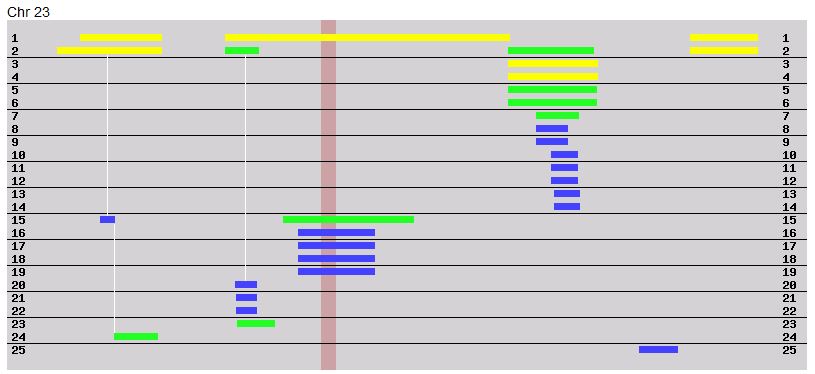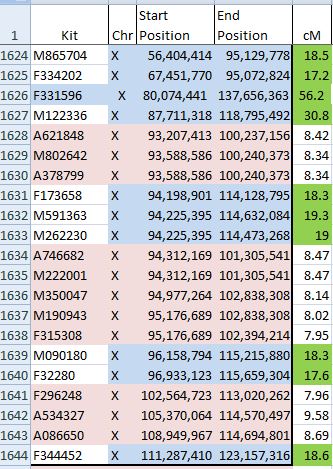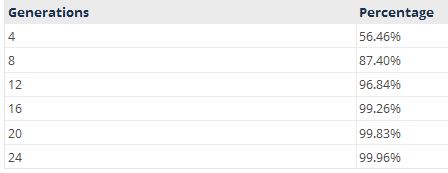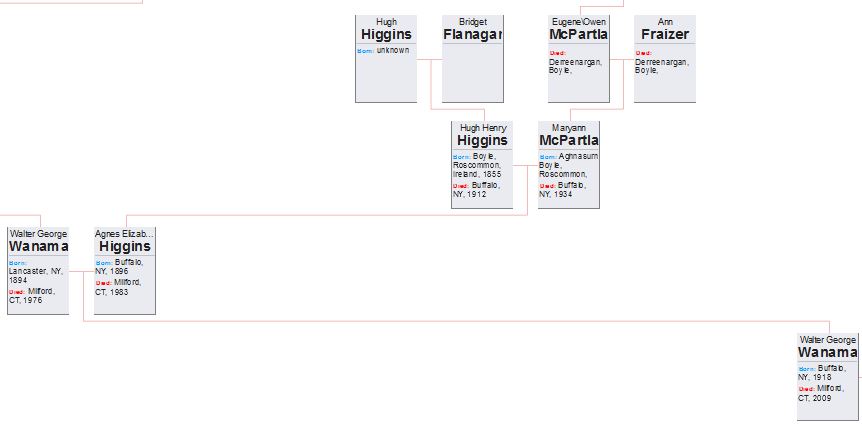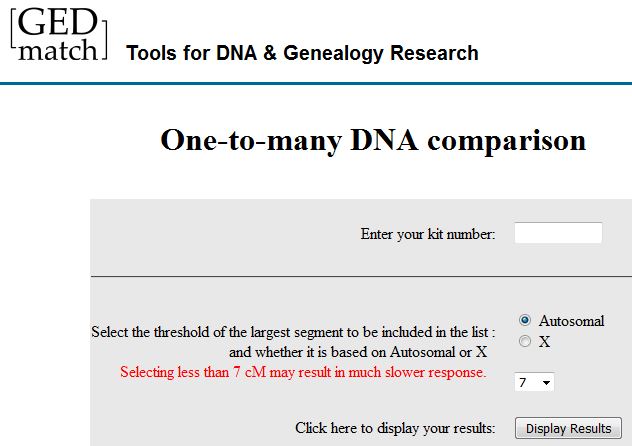This is my 3rd Blog on the X Chromosome. In my first blog, I wrote about a large match my sister Sharon had with a previously unknown woman named Karen and where it likely came from along the lines of my Irish Frazer ancestors. In the next Blog I wrote more about that match and how Charlotte who was already in the Frazer DNA project matched and triangulated with my sister Sharon and Karen. My earlier posts:
What is DNA Phasing?
DNA phasing is determining which side your DNA matches are on. According to ISOGG which is generally my standard reference source:
…it is the process of trying to determine which DNA came from the mother, and which came from the father. The term is usually applied to types of DNA that recombine, such as autosomal DNA or the X-chromosome. The benefit of phasing is being able to identify which ancestor a segment was inherited from.
In this blog I’ll just be writing about the X-chromosome phasing.
My Easy Male X Phasing
For males, the phasing is easy. I got all my only X-chromosome from my mother. That means my X is already phased. That’s the good news. The bad news is that I have hardly any X matches. I have 8 X matches at Gedmatch above 10 cM. This is not counting my mom and 2 sisters. However 4 of those 8 have the same email address. That means that it is likely that they are related to each other. Here are my top 8 non-immediate family X matches from Gedmatch.com:
As I mentioned they are already phased as they are all from my mom. Here are a few observation on my few X matches (which Gedmatch labels Chr 23):
- It appears that matches 3-7 match each other. This may be verified by performing a ‘one to one’ analysis at gedmatch. If they match each other, that would mean they triangulate and come from a common set of ancestors. When I checked match 3 against match 4, it appears that they are closely related as I expected. When I checked match 3 against the shorter match 7, I show a match. That means, as expected, I appear to be in a triangulation group with the 4 in the same family plus match #7.
- From the details which are not shown, 7 of the 8 of these are from Ancestry. I am able to email these people and if they respond I may be able to see their Ancestry Trees and determine where these matches may be.
- Matches 1, 2, and 8 show little to no overlap with each other and show no overlap with the larger group of matches.
Phasing My Sister’s DNA
In order to see any Paternal X matches, I will have to go to my sisters’ results. Each of my sisters got an X Chromosome from my dad. In fact, what they got from my dad was the same X that he got from his mom unchanged. But before, we get to my sisters’ paternal X, we’ll look at the maternal. My sisters also each received an X Chromosome from our mother.
My Sister’s X Maternally Phased
Wherever I match my sisters, this would also have to represent their maternal matches. So in a sense I am being used to maternally phase my sisters. Here is how I match them using the same gedmatch browser.
Here, my #1 and #2 matches are my sisters Heidi and Sharon. Matches 3-10 are the same as my old matches 1-8 above. A few notes:
- The colored segments in #1 and #2 represent the maternal X matches I share with my 2 sisters.
- This shows how my sisters match my numbers 8, 9, and 10 matches.
- Remember my cluster of matches that I thought should triangulate? Heidi (#1) doesn’t clearly match that group, but my sister Sharon (#2) does.
- On the top right, I match my sisters, but we match none of my other matches below. I suspect that has to do with my mother’s father. He immigrated to the U.S. from Latvia in the early 1900’s and has very few DNA matches that I have found so far. When I search for Rathfelder or Gangnus in my DNA matches, I haven’t found anything so far. Some of the more distant German ancestors names come up, but not these.
- Just looking at the groupings with my sisters, there are 4 different groupings. These represent segments my mother inherited from some of her ancestors. I say some, because she inherited no X from her father’s father. X is never passed down from father to son.
How Is This Helpful?
It is always helpful to know whether a match is on the maternal or paternal side. This eliminates half of your matches. DNA analysis can be looked at as a narrowing down process. Narrowing down 1/2 of many thousand autosomal matches can save a lot of time. However X Chromosome matches narrow down further. If there is a maternal X match, I know that it has to be in the following blue or pink areas of my mother’s ancestors.
These matches are even narrowed down further. That is because in order to have a true X match you have to show that the person you are matching is also matching on the X Inheritance portion (pink or blue) of their own chart.
Finally, here are all my X matches from Gedmatch (except for my mom). There is a reason I’m showing you this.
Now I see 5 groupings.
- In the second grouping under my longest match with #1 (Heidi), there are 2 subgroupings. These likely represent older families beneath the more recent family above them.
- The 4th group (of one) #25 only matches me and no one else – not even my sisters.
- Now look at my mother’s pink and blue chart above. At her great grandparent level, there are 5 people she could have gotten her X Chromosomes from. These are Gangnus, Lütke, Baker, Nicholson, and Ellis. It is possible that these 5 segments represent those families.
- As I mentioned above, I have not come up with the surname Gangnus in any of my DNA searches so far. That tells me that Group 5 or the top right match with only my 2 sisters and no one else could represent the X Chromosome portion that we received from my mother’s great grandfather. He was Johann Philipp Gangnus born on 22 May 1829 at Hirschenhof, Latvia.
One of the reasons that I’m looking at my X results in such detail is that I don’t have many of them. The male X matches can be more significant that the female X matches. This is because the male’s matches are already phased. At a lower cM level, they are more likely to be real matches.
A Second Look: Phasing by Ancestry Composition
In my 5 grouping theory above, I guessed that I may have inherited all 5 of my mother’s possible X match families. Unfortunately, I have reason to doubt that. One reason is, that in my limited reading on the subject, the X Chromosome can be quirky and come down as an all or nothing thing. In other words, it would be unlikely that I would inherit all of these families’ X Chromosomes.
Not many companies look at the ancestry composition of the X Chromosome. I’m not sure why. I’ve tested at 23andme and they do. 23andme shows me as the following, taking into consideration all Chromosomes (1-22) and the X Chromosome:
This information is put on a chromosome browser. Note that there is a maternal and paternal section of the browser. Unfortunately, not having my mom tested at 23andme, I can’t tell which half is maternal and which is paternal. Also note there is just one line for the X Chromosome which for me is the only possible maternally matched X Chromosome.
It is difficult to make out the differences in the blues, but when I look at the French and German side, I get the entire X Chromosome as well as some other chromosomes. As far as I know, my Nicholson and Ellis ancestors were from deep within England. If 23andme is right, it seems to indicate that I didn’t get any Nicholson or Ellis X Chromosome or it would show some X Ancestry as being British & Irish. My mother’s other X ancestors were German – either of late or from around colonial Philadelphia.
This means that I would have to go back another generation on the pink and blue chart above. This represents my mother’s 2nd great grandparents. When I take out the Nicholson and Ellis families, that still leaves me with 5 German families: Biedermann, Luetke, Fuhrmann, Baker and Faunce. My suspicions seem to be confirmed by my second cousin. Judy has tested at 23andme.
Judy, Where’s Our X Match?
Judy and I have many matches, but none on the X Chromosome. Based on the X Chromosome inheritance, I’m in line to share an X with her from our Nicholson ancestors. There are 3 possible reasons we may not share an X match: 1) my Nicholson X dropped out; 2) her Nicholson X dropped out; or 3) both of our Nicholson X’s dropped out! Perhaps Judy will upload her results to Gedmatch.com and we will be able to figure out more on how we match or don’t match based on my 2 sisters’ matches with her.
Above is the chart showing that Judy and I could share an X, but according to 23andme, we don’t. A few notes on this chart:
- Judy and I have the potential to share Annie Nicholson’s X chromosome.
- Jacob Lentz’ X makes it down to me (through Emma), but not down to Judy.
- Wm Nicholson Lentz got his only X from his Nicholson mother
- My grandmother Emma had a recombined X from her parents. Likewise my mom had a recombined X from her parents.
- Likewise Judy’s mother had recombined X from her grandparents, and Judy had recombined X from her parents.
- That means between Judy and me, Annie Nicholson’s X chromosome could have recombined at total of 4 times (2 on each side).
- When I say recombined, I mean potentially recombined. The X sometimes ‘decides’ not to combine. Apparently that happened on one or both sides as Judy and I don’t share any or Annie’s red X Chromosome.
On To the Male Phasing of the X Chromosome
This is where I drop out. As a male I’m pretty useless. (I left that one wide open.) I’ll have to switch to my sisters’ matches now. One way to find out my sisters’ male phased X Chromosomes would be to compare their matches to a cousin. Unfortunately, I didn’t get my paternal cousin to test. I emailed, but got no response. Here’s how it would’ve worked out:
The red shows that my sister and her paternal 1st cousin would share my father’s mother’s X Chromosome inheritance. But how would we ever find the X for my father’s father? The answer is that we couldn’t for my sisters because they only got my father’s X that he got from his mother which is unrecombined Frazer DNA. However, I have had my father’s 1st male cousin tested. He inherited an X from his mother who was a Hartley (my grandfather’s sister). So his X Chromosome should match with my paternal first cousin’s X Chromosome. This is because my Aunt got her Hartley X Chromosome from her father. And he got his from his mother who was a Snell. So it still doesn’t get at the Hartley Chromosome so much but gets closer to that side.
I think this is what ISOGG means when it simply says:
To phase your X-chromosome, all you need is knowledge of your ancestry.
It seems you need knowledge of your ancestry plus a lot of testing.
Any Other Ideas?
As I look at my spreadsheet for Heidi, her results from gedmatch are phased. How did this happen? Here is a portion of the chart:
Here the blue would be paternal X and the pink is maternal for Heidi’s matches. The large 56.2 match was discussed in my previous blogs and was believed to be from the Frazer side (which is my family’s paternal side). When I got my sister’s raw DNA results and uploaded them to gedmatch, I had them phased. Gedmatch has a program that takes your results and one of your parents and based on those results puts your results into a paternal file and a maternal file. I took the maternal side and ran all the matches at gedmatch. Then I took the paternal side of Heidi’s matches and ran all the matches. I combined the 2 and voilà got one file showing paternal and maternal matches for Heidi. This worked for Chromosomes 1-22 as well as the X Chromosome.
Sharon’s X Matches
Here the matches to my sister Sharon with a Kit # are from Gedmatch. The other matches are from FTDNA. For some reason I didn’t get around to adding Heidi’s FTDNA matches. The 96.4 cM match is between Sharon and our mom. Blue shaded matches are Paternal and pink are Maternal.
Check Your Work
When I was in school, I was told to ‘check your work’. Here under Sharon’s match with A111074, I have a note on my spreadsheet that something doesn’t seem to add up. In this case, there are 2 ways to check if a particular match should be a paternal or maternal match.
- If I have the same match, as a male, that would have to be a maternal match for Sharon.
- I have Sharon phased. I can check Sharon’s maternal and paternal phased kits and see which one matches A111074.
From my spreadsheet, here is my X match with A111074
Oops, A111074 matches me. That means she has to match Sharon on my mom’s side. When I check A111074 against Sharon’s phased kits, she matches Sharon’s maternal phased kit and not the paternal phased kit. So I need to correct this match of Sharon from paternal to maternal.
What If You Don’t Have a Parent to Test?
Having a parent to test can make the phasing part easy. If you don’t have a parent to test there are some other options:
- Test cousins that would have shared X matches as mentioned above
- Women may test a brother to find maternal only X matches
- Triangulate to find groups. These groups will be either maternal or paternal – however your won’t know which. If you determine on maternal or paternal match in the group, the others will be the same.
- If your parents are from different backgrounds the paternal or maternal aspect may sort out by matching others of those backgrounds. The fact that my X Chromosome seems to be all German as shown above is one example of how to do this. Another example would be my mother in law. Her mother’s side of the family was from Newfoundland. Her father’s side was from Prince Edward Island. She has a lot of matches with people with ancestors from these 2 places. In most cases that sorts out her matches into maternal or paternal – depending from which island they were from.
In summary:
- All autosomal DNA has a maternal and paternal side. The one exception is the male tester’s X Chromosome. His is all maternal.
- Knowing if your matches are maternal or paternal takes away a lot of guesswork in your matches.
- Knowing your own X inheritance pattern as well as your match’s X inheritance pattern will give clues to where that match could be.




